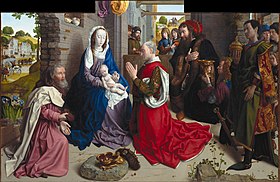Hugo van der Goes
 |
|
|
|
Hugo van der Goes (probably Ghent c. 1430/1440 – Auderghem 1482) was one of the most important Flemish painters of the late 15th century. He introduced important innovations such as a new monumentalism, a specific colour spectrum and an individualistic manner of portraiture. The presence of his masterpiece, the Portinari Triptych in Florence, from the late-15th century onwards played a role in the development of realism in Italian Renaissance art.
Hugo van der Goes was likely born in Ghent or its environs around 1440. Nothing is known with certainty about the artist's life prior to 1467, when he became a master in the painters' guild in Ghent. The sponsors for his membership of the guild were Joos van Wassenhove, master painter in Ghent from 1464, and Daneel Ruthaert. It is likely that he had trained elsewhere before he became a master in Ghent. Some historians have suggested that Dieric Bouts was possibly the master of van der Goes but there is no independent evidence for this.
In 1468 the artist was commissioned by the city of Ghent to execute some works in connection with the grant of the Great Indulgence of the city. In the following years, van der Goes created further decorations such as papal blazons at the behest of the city. In 1468 he was in the town of Bruges making decorations to celebrate the marriage between Charles the Bold and Margaret of York. On 18 October 1468 van der Goes and other members of the painter's guild invited painters from Tournai to their assembly in Ghent on the occasion of St. Luke's day. St. Luke was the patron saint of painters.
In 1469 Hugo van der Goes and Joos van Wassenhove vouched for Alexander Bening for his entry as a master in the Ghent painter's guild. In 1480 Alexander Bening married Catherina van der Goes, a cousin of Hugo van der Goes. Van der Goes and his workshop worked on commissions of the city of Ghent to provide heraldic decorations for Charles the Bold's Joyous Entry in Ghent in 1469 and later in 1472.
...
Wikipedia
